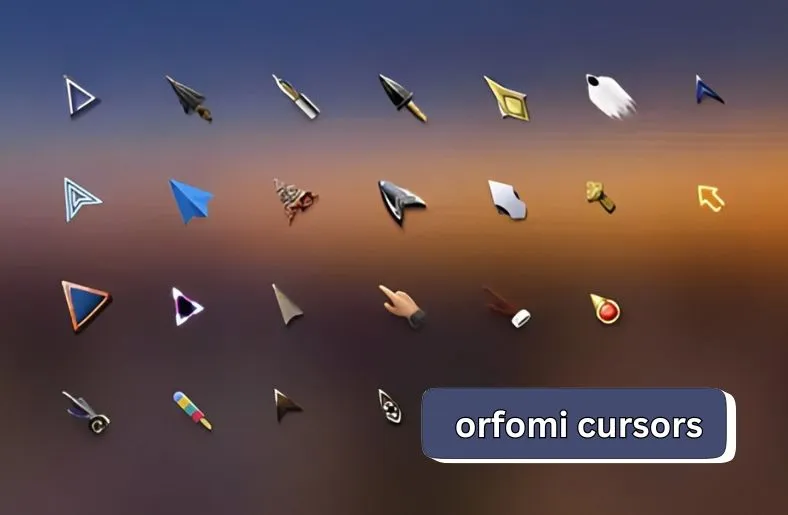I. Introduction
Cursor design plays a crucial role in how we interact with computers and applications. A well-designed cursor can enhance navigation, making digital experiences smoother and more intuitive. Users often overlook cursors, but they significantly impact how we engage with digital content.
Among the latest innovations in cursor design are orfomi cursors. These cursors aim to transform user interaction by offering dynamic features that standard cursors lack. Unlike traditional cursors, which can be static and uninspiring, orfomi cursors adapt based on the user’s actions and the context of their tasks.
This blog post aims to explore the future of cursor design through the lens of orfomi cursors. We will delve into their unique features, evolution, and practical applications, showcasing how they can enhance user experience. Ultimately, this exploration will reveal the exciting potential of orfomi cursors in shaping digital interactions.
II. What are Orfomi Cursors?
Orfomi cursors are a new type of cursor designed to enhance user interaction with digital interfaces. They are characterized by their ability to change appearance based on the user’s actions, providing immediate visual feedback. This dynamic quality sets them apart from traditional cursors, which remain static regardless of context.
One of the unique features of orfomi cursors is their adaptability. Designers can customize these cursors to suit the specific needs of different projects. Whether for a fun gaming website or a professional business platform, orfomi cursors can be tailored to fit the overall aesthetic and functionality of the site.
Additionally, orfomi cursors offer a level of interactivity that enhances user engagement. For instance, when a user hovers over a clickable element, the cursor can change shape or color, indicating that an action is available. This immediate feedback helps users understand their interactions better, making digital navigation more intuitive.
Overall, orfomi cursors represent a significant advancement in cursor design, combining functionality and aesthetics. They allow for a more engaging user experience, making them a valuable tool for designers and developers.
III. The Evolution of Cursor Design
Cursor design has a rich history, evolving significantly since the early days of computing. Initially, cursors were simple arrows used primarily for pointing and clicking. Their functionality was limited, and they often lacked visual appeal or interactivity.
As technology advanced, designers began to recognize the need for more engaging cursor options. Traditional cursors often failed to provide adequate visual feedback, which hindered user experience. This realization led to the development of more dynamic cursor designs that respond to user actions.
Orfomi cursors mark the next step in this evolutionary journey. They incorporate innovative features that address the limitations of traditional cursors. By offering adaptability and interactivity, orfomi cursors enhance the user experience, allowing for more intuitive navigation.
As we move forward, the shift from static to dynamic cursor design will play a crucial role in enhancing how we interact with digital environments. The future of cursor design lies in creating tools that not only serve a functional purpose but also engage and delight users.
IV. Importance of Cursor Design in User Experience
Cursor design is a key component of user experience (UX) that often goes unnoticed. A well-crafted cursor can significantly improve how users interact with digital interfaces. It helps guide users through tasks, making navigation smoother and more intuitive. A cursor that is easy to see and understand can enhance user confidence, resulting in a better overall experience.
Orfomi cursors play a pivotal role in enhancing UX through clear visual feedback. For example, when a user hovers over an interactive element, the cursor can change in appearance to indicate that an action is available. This immediate response helps users understand what they can do next, reducing confusion and improving usability.
Moreover, orfomi cursors can be customized to align with a project’s design, creating a cohesive visual experience. This alignment makes interfaces more appealing and encourages user engagement. When users feel that their interactions are recognized and meaningful, they are more likely to stay engaged with the content.
In summary, investing in effective cursor design, like orfomi cursors, is crucial for enhancing user satisfaction. By improving clarity and interactivity, these cursors contribute to a more enjoyable and efficient user experience.
V. Customization Options with Orfomi Cursors
One of the standout features of orfomi cursors is the wide range of customization options available. Designers can create cursors that fit their specific projects, offering an opportunity for creativity and innovation. This level of customization is essential in today’s digital landscape, where user expectations are high.
Customization can include various elements, such as shapes, sizes, colors, and animations. For instance, a website focused on children might use bright, playful cursor designs to attract their audience. In contrast, a corporate website may opt for sleek, minimalistic cursors that reflect professionalism.
Additionally, orfomi cursors can change based on user actions, further enhancing their effectiveness. For example, a cursor could morph into a hand when hovering over a link, providing visual cues that guide users. This responsiveness makes the user experience more engaging and helps users feel more connected to the interface.
Overall, the possibilities for customizing orfomi cursors are vast. By leveraging these features, designers can create unique and memorable experiences that resonate with users, ultimately enhancing the overall effectiveness of their projects.
VI. Practical Applications of Orfomi Cursors
Orfomi cursors find practical applications across various industries, proving their versatility and effectiveness. In web design, these cursors can significantly enhance navigation and user engagement. For example, a news website could use orfomi cursors to highlight clickable articles, helping readers easily navigate through content.
In the gaming industry, orfomi cursors can transform user interfaces by reacting to in-game actions. A racing game, for instance, could feature cursors that change shape or color based on speed, providing players with immediate feedback. This interactivity adds excitement and clarity to the gaming experience.
Educational software can also benefit from orfomi cursors. They can serve as visual cues for learning activities, making it easier for students to engage with content. For example, a cursor that highlights correct answers in a quiz can boost confidence and encourage participation.
Overall, the versatility of orfomi cursors allows them to be seamlessly integrated into various projects. Their ability to enhance user experience and engagement makes them a valuable tool for designers and developers across different sectors.
VII. Integration of Orfomi Cursors into Projects
Integrating orfomi cursors into projects is a straightforward process that can greatly enhance user experience. The first step is to identify the specific needs of your project. Understanding how orfomi can improve your interface will help guide your design choices.
Next, explore the tools and platforms available for creating orfomi cursors. Many design software options offer user-friendly features for customizing cursors. These tools allow you to experiment with colors, shapes, and animations, ensuring your cursors align with your project’s vision.
Once you’ve created your custom cursors, the next step is integration. This may involve using coding languages like CSS or JavaScript to implement the cursors effectively. It’s essential to ensure that the cursors are responsive and function well across different devices and browsers.
Finally, follow best practices for performance optimization. This can include simplifying designs or reducing animation complexity to avoid lag. By thoughtfully integrating orfomi , you can create an engaging and interactive interface that keeps users returning for more.
VIII. The Future of Orfomi Cursors
The future of orfomi cursors is filled with exciting possibilities. As technology continues to advance, we can expect more sophisticated and interactive cursor designs. For example, integrating artificial intelligence may lead to smart cursors that adapt to user preferences and behaviors.
Furthermore, the growing focus on user experience will drive the demand for innovative cursor solutions. Designers will consistently seek new ways to enhance digital interactions, making orfomi well-positioned to meet these evolving needs.
As virtual and augmented reality technologies become more prevalent, orfomi may also be adapted for these environments. This could lead to entirely new ways of interacting with digital content, enhancing user engagement even further.
Conclusion
In conclusion, orfomi cursors represent a groundbreaking advancement in cursor design, transforming how users interact with digital environments. Their adaptability, customization options, and interactive features enhance user experience, making navigation more intuitive and engaging. As technology continues to evolve, the potential for orfomi to integrate with emerging trends like artificial intelligence and virtual reality is promising. By prioritizing effective cursor design, developers can create richer, more immersive digital experiences, ultimately leading to greater user satisfaction and engagement. The future of cursor design lies in innovations like orfomi , paving the way for a more dynamic interaction with technology.




